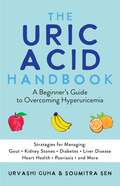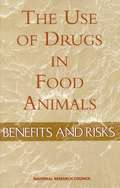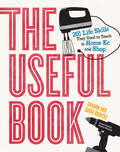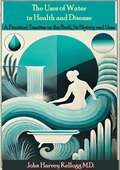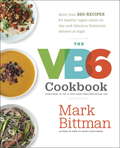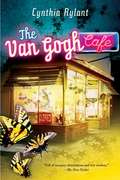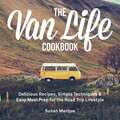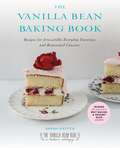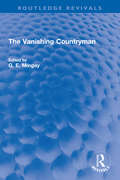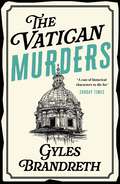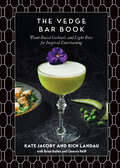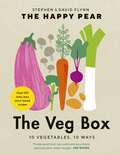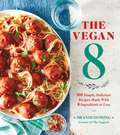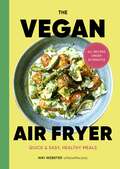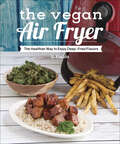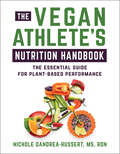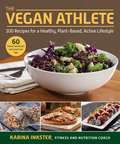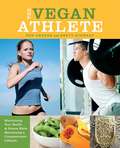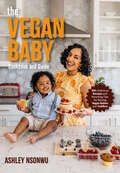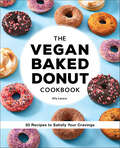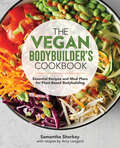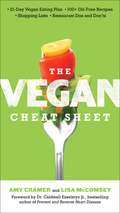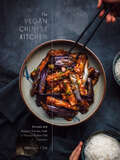- Table View
- List View
The Uric Acid Handbook: A Beginner's Guide to Overcoming Hyperuricemia (Strategies for Managing: Gout, Kidney Stones, Diabetes, Liver Disease, Heart Health, Psoriasis, and More)
by Urvashi GuhaTake control of your health with this easy-to-use guide to lowering uric acid levels and managing gout, liver disease, heart health, and more!Millions of Americans experience high uric acid levels, aka hyperuricemia, and as a result suffer from health conditions like gout, liver disease, kidney stones, heart disease and more. Uric acid is a waste product found in the blood. The body naturally dissolves uric acid, but sometimes it can build up in the body and cause major health problems. With The Uric Acid Handbook, you will first learn what uric acid is and how it operates within your body. Then this book will walk you through how you may be unknowingly increasing your uric acid levels and the certain health risks associated with doing so. Using relatable anecdotes and research-backed strategies, this friendly guide will give you all the tools you need to lower your uric acid levels, including: Professional advice from health-care providers Recipes and recommended foods that are low in uric acid Simple strategies for making daily lifestyle changes And more! The Uric Acid Handbook is the ultimate fact-filled guide to managing your hyperuricemia or simply improving your overall health.
The Use Of Drugs In Food Animals: Benefits And Risks
by National Research CouncilThe use of drugs in food animal production has resulted in benefits throughout the food industry; however, their use has also raised public health safety concerns.The Use of Drugs in Food Animals provides an overview of why and how drugs are used in the major food-producing animal industries--poultry, dairy, beef, swine, and aquaculture. The volume discusses the prevalence of human pathogens in foods of animal origin. It also addresses the transfer of resistance in animal microbes to human pathogens and the resulting risk of human disease.The committee offers analysis and insight into these areas Monitoring of drug residues. The book provides a brief overview of how the FDA and USDA monitor drug residues in foods of animal origin and describes quality assurance programs initiated by the poultry, dairy, beef, and swine industries.Antibiotic resistance. The committee reports what is known about this controversial problem and its potential effect on human health. The volume also looks at how drug use may be minimized with new approaches in genetics, nutrition, and animal management. November
The Useful Book: 201 Life Skills They Used to Teach in Home Ec and Shop
by David Bowers Sharon BowersA modern and energetically designed encyclopedia of DIY with everything you need to know to roll up your sleeves and cook it, build it, sew it, clean it, or repair it yourself. In other words, everything you would have learned from your shop and home ec teachers, if you'd had them.The Useful Book features 138 practical projects and how-tos, with step-by-step instructions and illustrations, relevant charts, sidebars, lists, and handy toolboxes. There’s a kitchen crash course, including the must-haves for a well-stocked pantry; how to boil an egg (and peel it frustration-free); how to grill, steam, sauté, and roast vegetables. There’s Sewing 101, plus how to fold a fitted sheet, tie a tie, mop a floor, make a bed, and set the table for a formal dinner. Next up: a 21st-century shop class. The tools that everyone should have, and dozens of cool projects that teach fundamental techniques. Practice measuring, cutting, and nailing by building a birdhouse. Make a bookshelf or a riveted metal picture frame. Plus: do-it-yourself plumbing; car repair basics; and home maintenance, from priming and painting to refinishing wood floors.
The Uses of Water in Health and Disease. A Practical Treatise on the Bath, Its History and Uses
by John Harvey KelloggThe Uses of Water in Health and Disease by John H. Kellogg is a comprehensive and practical guide to hydrotherapy, exploring the therapeutic applications of water for promoting health and treating various ailments. Written by the renowned physician and health reformer, this book reflects Kellogg’s expertise in natural health practices, focusing on the healing potential of water treatments such as baths, showers, compresses, and other hydrotherapeutic methods.Kellogg offers a detailed history of the bath, tracing its use from ancient civilizations to modern times, highlighting how cultures across the world have harnessed water for wellness. The book covers various forms of water therapy, including cold baths, steam baths, and sitz baths, explaining the physiological effects each method has on the body. Kellogg emphasizes how water therapy can improve circulation, stimulate the nervous system, detoxify the body, and strengthen immunity.Beyond the practical techniques, the book also delves into how water treatments can complement medical care in treating chronic conditions, fevers, skin diseases, digestive disorders, and mental health challenges. Kellogg provides guidelines for administering water therapy safely at home, detailing the proper temperatures, durations, and sequences for different treatments to achieve optimal results.Written in an accessible yet authoritative style, The Uses of Water in Health and Disease reflects Kellogg’s philosophy of holistic health, where natural remedies, preventive care, and lifestyle choices play central roles in maintaining well-being. This book appeals to health professionals, wellness enthusiasts, and anyone interested in alternative medicine and the history of health practices. Kellogg’s insights continue to resonate, offering practical advice on integrating hydrotherapy into modern self-care routines.
The VB6 Cookbook: More Than 350 Recipes For Healthy Vegan Meals All Day And Delicious Flexitarian Dinners At Night
by Mark BittmanFollowing up on his bestselling diet plan, VB6, the incomparable Mark Bittman delivers a full cookbook of recipes designed to help you eat vegan every day before 6:00 p.m.--and deliciously all of the time. This special iBooks Author edition of the VB6 Cookbook invites you to: - Plan a day, week, or month of meals, or cook from Mark's 28-day VB6 menu and adjust it to suit the way you live. - Cook from step-by-step instructions. When you're ready to start cooking, seamlessly switch to landscape mode and view the recipe steps in an easy-to-read format that you can see from across the kitchen counter. - Shop quickly and easily. Pick out the recipes or parts of your menu that you want to make, and gather an aggregated list of the ingredients you need, which you can email to yourself or shop from right in the ebook. - Discover ingredient characteristics with an interactive spinner, learning about the Unlimited, Flexible, and Treat foods that make up the core of VB6. - Connect to Mark's Twitter feed and tweet back from your own kitchen--without closing the ebook. In VB6, bestselling author and New York Times columnist Mark Bittman created an easy-to-follow diet plan for vegan meals for breakfast and lunch, and healthy, vegetable-forward meals for everyday. Now in this tie-in cookbook, Bittman expands on the VB6 diet with a collection of brand new recipes and variations sto keep the diet going and to keep eating better. It's no surprise that when you eat lots of fruits and veggies and cut back on meat and dairy, your health can improve. Bittman's reliably simple, straightforward approach to cooking, and thoughtful approach to eating more plant foods, will make this a must-cook book for both VB6 diet converts and for anyone looking to lose weight and cook, eat, and live healthier.From the Hardcover edition.
The Van Gogh Cafe
by Cynthia RylantThe Van Gogh Cafe, located in Flowers, Kansas, has magic in its walls, causing strange and mysterious events to occur there.
The Van Life Cookbook: Delicious Recipes, Simple Techniques and Easy Meal Prep for the Road Trip Lifestyle
by Susan MarqueGet cooking in your sprinter van, camper van, or RV with the creative, flavorful recipes especially crafted for making meals in tight spaces while on the road!You&’ve finally finished your van build and are ready to hit the road. But just as you&’ll have to adapt your lifestyle to the open road, you&’ll have to do the same with breakfast, lunch, and dinner. The Van Life Cookbook, a collection of recipes and full-color photographs, celebrates the road trip lifestyle and #vanlife community while providing delicious and nutritious meal ideas for modern-day nomads. With meal prep tips, pantry advice, and hacks on cooking in a tiny kitchen, you&’ll be whipping up flavor-packed dishes in no time. Plus, with serving sizes catered to one or two people, you&’ll never have to worry about leftovers crowding your mini fridge. Discover the joys of cooking on the road with dishes like: Breakfast Biscuits on the Burner Chickpea Avocado Salad Van Life Summer Rolls Personal Pizzas Single-Serving Dessert Crisp And much more!
The Vanilla Bean Baking Book: Recipes for Irresistible Everyday Favorites and Reinvented Classics
by Sarah KiefferA beautiful and thoughtful baking book with 100 recipes for delicious treats and desserts from the founder of the Saveur Award-winning Vanilla Bean baking blog.Readers find the Vanilla Bean blog while hunting for the perfect chocolate cake or cinnamon roll recipe, or another everyday favorite. They stay for founder Sarah Kieffer's simple approach to home baking, the utterly transporting, dreamlike quality of her photography, and her evocative storytelling. Most of all, the Vanilla Bean blog celebrates the soulfulness of baking. Kieffer mastered the art of home baking while working in tiny kitchens in the back of coffeehouses and bakeries in Minnesota. She began the Vanilla Bean blog to create a culinary heritage for her family, but soon became passionate about making the joys of baking accessible for all. With recipes that help simplify the process behind complicated techniques, Vanilla Bean has built a dedicated following of several hundred thousand loyal readers and won several awards, including the Reader's Choice Award for best baking blog from Saveur.The Vanilla Bean Baking Book is Kieffer's debut cookbook, with 100 delicious tried-and-true recipes for the home baker. From everyday favorites such as Lemon Bread and Peanut Butter Cookies to inventive twists on classics such as Burnt Honey Buttercream Cake with Chocolate, Coffee Blondies, and Apple-Blackberry Turnovers, these irresistible treats will delight and inspire.
The Vanilla Bean Baking Book: Recipes for Irresistible Everyday Favorites and Reinvented Classics
by Sarah KiefferA beautiful and thoughtful baking book with 100 recipes for delicious treats and desserts from the founder of the Saveur Award–winning Vanilla Bean baking blog.Readers find the Vanilla Bean blog while hunting for the perfect chocolate cake or cinnamon roll recipe, or another everyday favorite. They stay for founder Sarah Kieffer’s simple approach to home baking, the utterly transporting, dreamlike quality of her photography, and her evocative storytelling. Most of all, the Vanilla Bean blog celebrates the soulfulness of baking. Kieffer mastered the art of home baking while working in tiny kitchens in the back of coffeehouses and bakeries in Minnesota. She began the Vanilla Bean blog to create a culinary heritage for her family, but soon became passionate about making the joys of baking accessible for all. With recipes that help simplify the process behind complicated techniques, Vanilla Bean has built a dedicated following of several hundred thousand loyal readers and won several awards, including the Reader’s Choice Award for best baking blog from Saveur.The Vanilla Bean Baking Book is Kieffer’s debut cookbook, with 100 delicious tried-and-true recipes for the home baker. From everyday favorites such as Lemon Bread and Peanut Butter Cookies to inventive twists on classics such as Burnt Honey Buttercream Cake with Chocolate, Coffee Blondies, and Apple-Blackberry Turnovers, these irresistible treats will delight and inspire.
The Vanishing Countryman (Routledge Revivals)
by G. E. MingayFirst published in 1989, The Vanishing Countryman investigates how farmers, farm workers, and other country crafts- and tradespeople have fared in response to significant changes across the British countryside in the past one hundred years. The book explores the move towards large-scale and capital-intensive farming, and the conflict between increased production and damage to the environment. It looks at the decline in the number of farm workers, crafts- and tradespeople. It also considers the changes in social composition across country villages and the impact that this has had on living standards, housing, and transport. The Vanishing Countryman will appeal to those with an interest in rural and social history, and in the history of the British countryside specifically.
The Vatican Murders: The Victorian Murder Mystery Series: 5 (The Victorian Murder Mystery Series #5)
by Gyles Brandreth'An exciting period murder mystery' Reader review ⭐⭐⭐⭐⭐'If you want a fun mystery to read, I highly recommend it' Reader review ⭐⭐⭐⭐⭐'Couldn't put it down!!' Reader review ⭐⭐⭐⭐⭐Does death await you in The Eternal City?1892: Arthur Conan Doyle is intrigued when he first begins to receive mysterious packages addressed to his famous fictional detective Sherlock Holmes.But the contents of the parcels are as gruesome and cryptic as any case Holmes himself tackled: a lock of hair, a severed finger wearing a gold ring, and the hand of a dead man.The only clue to who has sent them is the postmark from Rome.Doyle's friend and fellow author Oscar Wilde persuades him they must track down the perpetrator and identify the victims.Arriving in Italy, their investigation leads them to connect the parcels with the disappearance of a young girl and to the glittering Vatican City . . .With danger and death stalking them at every corner, can they unmask the killer before he catches up with them?A wonderfully witty and gripping cosy historical murder mystery with twists and turns aplenty. Perfect for fans of Sherlock Holmes, Agatha Christie and Richard Osman.Readers love The Vatican Murders:'The plot is constructed wonderfully . . . jumps off the page' Reader review ⭐⭐⭐⭐⭐'A truly enjoyable read from start to finish' Reader review ⭐⭐⭐⭐⭐'This is an excellent mystery series starring Oscar Wilde and Arthur Conan Doyle among others. Great plots with a mix of history and interesting characters. Totally entertaining' Reader review ⭐⭐⭐⭐⭐'Simply delightful' Reader review ⭐⭐⭐⭐⭐
The Vedge Bar Book: Plant-Based Cocktails and Light Bites for Inspired Entertaining
by Kate Jacoby Rich LandauEverything you need for a memorable cocktail hour is right here—with 75 innovative plant-based drinks and snacks “Sophisticated, contemporary, and worth every sip.”—Dan Buettner, Blue Zones founder and bestselling author At Vedge, the award-winning Philadelphia restaurant that pioneered plant-based fine dining, Kate Jacoby, Rich Landau, and their acclaimed team have been elevating vegetable cooking—and imbibing—for well over a decade. They believe a good drink is an indulgent, multisensory experience worth savoring—and even better when paired with the right snack or small plate and enjoyed among friends. Drawing inspiration from fresh produce and the rhythms of nature, the 75 all-vegan drinks, bar snacks, and small plates shared here are some of their most beloved creations, with imaginative flavor combinations you’ll find nowhere else. Drinks that capture the essence of the season: Daffodil, Smoked Corn Silk Old Fashioned, Golden Apple Fruity refreshers: Per My Last Email, Even Cowgirls Get the Blues, Strawberry Smash Holiday party–worthy sips: Bury the Hatchett, Last-Minute Tradition, Old Acquaintance Inventive riffs on old classics: Fig Leaf Bourbon Sour, Afternoon Snack, Front Porch Swing Light bites and bar snacks: Sichuan Popcorn, Lima Bean Pistou on Toast, Skewered Shiitakes with Buttered Corn Sauce, Rutabaga Fondue You’ll also find a guide to essential tools and ingredients, plus tips for mastering key techniques and garnishing like a pro. Contemporary, exuberant, and totally irresistible, The Vedge Bar Book is a sensual celebration and a must-have for holiday hosts, cocktail connoisseurs, and plant-based foodies alike.
The Veg Box: 10 Vegetables, 10 Ways
by Stephen Flynn David FlynnDavid and Stephen Flynn, a.k.a the Happy Pear twins, are back with their simplest cookbook yet!The perfect collection for vegans, vegetarians, or anyone looking to eat more plant-based recipes - 'This book is awesome' Chris EvansAUBERGINE - BEETROOT - BROCCOLI - CABBAGE - CARROT - CAULIFLOWER - COURGETTE - LEEK - MUSHROOMS - POTATOESTen vegetables, ten ways, The Veg Box makes cooking veg easier and tastier than ever before! This vibrant book is packed with over 100 new recipes that use just ten ingredients or less and showcase the delicious and diverse ways you can enjoy each vegetable.Take carrots for example. Learn how to transform this simple produce into:Carrot and Sesame BurgersRoasted Carrot TagineChewy Flapjacks with Carrot and PistachioOr how about courgettes? Watch them become:Easy One-Pan Courgette PizzaCourgette Crepes with Spinach and RicottaCourgette and Lemon Loaf Cake with a Lemon Curd Building tips on eating more sustainably into family-friendly meals, quick weeknight dinners and sweet treats, this is healthy eating for our planet, our bodies and our tastebuds.'Proper good food, less waste and very simple, delicious plant-based recipes' Joe Wicks'Super practical and full of great recipes for eating more plants and reducing food waste' Fearne Cotton 'The lads have done it again! A great concept and a beautiful book to help us all cook more delicious veg' BOSH!'A delicious celebration of plants and all that they have to offer' Megan Rossi 'Their recipes are fantastic and you will love this book' Dr Rupy Aujla 'Delicious, sustainable meals everyone will enjoy' Dr Gemma Newman
The VegNews Guide to Being a Fabulous Vegan: Look Good, Feel Good & Do Good in 30 Days
by Jasmin Singer VegNews MagazineGo vegan the fabulous way with this helpful guide from an editor of VegNews, an award-winning vegan media outlet.Maybe you're interested in it for the food, maybe it's the animals, or maybe climate change has got you thinking. Whatever your reason, maybe you don't quite know where to start. After all, doesn't going vegan mean you have to give up tasty snacks, cool shoes, a sense of humor, and your leather couch? (Nope, nope, no way, well . . . eventually.) Covering everything from nutrition (you will get enough protein, promise) to dating (vegans have better sex. It's true) to fitness (you want to lift a car over your head? Sure), Jasmin Singer and the team at VegNews bust all the myths and give you all the facts about a plant-based lifestyle. With 30 easy recipes to get you started, The VegNews Guide to Being a Fabulous Vegan will help you adopt a lifestyle that's better for you, the animals, and the planet. And what's more fabulous than that?
The Vegan 8: 100 Simple, Delicious Recipes Made with 8 Ingredients or Less
by Brandi DomingFive years ago, popular blogger Brandi Doming of The Vegan 8 became a vegan, overhauling the way she and her family ate after a health diagnosis for her husband. The effects have been life-changing. Her recipes rely on refreshingly short ingredient lists that are ideal for anyone new to plant-based cooking or seeking simplified, wholesome, family-friendly options for weeknight dinners. All of the recipes are dairy-free and most are oil-free, gluten-free, and nut-free (if not, Brandi offers suitable alternatives), and ideally tailored to meet the needs of an array of health conditions. Each of the 100 recipes uses just 8 or fewer ingredients (not including salt, pepper, or water) to create satisfying, comforting meals from breakfast to dessert that your family—even the non-vegans—will love. Try Bakery-Style Blueberry Muffins, Fool ’Em “Cream Cheese” Spinach-Artichoke Dip, Cajun Veggie and Potato Chowder, Skillet Baked Mac n’ Cheese, and No-Bake Chocolate Espresso Fudge Cake.
The Vegan Air Fryer: Quick & easy, healthy meals
by Niki WebsterHealthy Eating Made Simple.This quick-and-easy cookbook makes healthy meal prep, and eating more veg, effortless.Everyone will love these delicious, vibrant breakfasts, snacks, lunches, dinners, baking and desserts cooked in your air fryer. If you’re new to vegan eating or have just got an air fryer, this book is for you.Find 70 plant-based recipes for beginners. Enjoy cooking:- Easy breakfasts- Simple lunches & light bites- Super quick meals – ready in 15 minutes or less- 30-minute meals - Bread, cakes, cookies & desserts
The Vegan Air Fryer: The Healthier Way to Enjoy Deep-Fried Flavors
by JL FieldsEighty recipes for vegan versions of yummy comfort foods from eggrolls to grilled cheese—without all that oil!If you love fried foods, but don’t want the oil, added fat, and mess, this cookbook shows you how to air-fry your favorite fried foods with little or no cooking oil. JL Fields, author of Vegan Pressure Cooking, has done the research, development, and testing, so you can serve crispy French fries, eggrolls, and all kinds of fried food in minutes—without frying.Bring crunchy onion rings, vegetable tempura, and other treats to your table without making a mess or heating up your kitchen. Now you can eat delicious “fried” food, while staying healthy. Recipes include low-fat vegan versions of: • Jalapeño Poppers• Vegetable Dumplings• Potato Chips• Eggrolls• Mac ‘n’ Cheese Bites• Buffalo Cauliflower• Corndogs• Fried Chick’n• Fajitas• Grilled Cheese Sandwiches, and more
The Vegan Athlete's Nutrition Handbook: The Essential Guide for Plant-Based Performance
by Nichole Dandrea-RussertUsing the latest research in sports nutrition, this handbook helps athletes maximize their performance, expedite recovery, and optimize their health through balanced, plant-based eating.Debunking the myth that a plant-based diet and high-intensity athleticism just don&’t mix, The Vegan Athlete's Nutrition Handbook is a comprehensive guidebook for anyone looking to dive deep into the science behind plant-based eating and peak performance. Making the choice to switch to a plant-based diet shouldn't mean giving up your gains — in fact, incorporating more plant-based foods may even give you an athletic advantage — provided you know how to properly fuel your body while eating vegan.The Vegan Athlete's Nutrition Handbook features:• Breakdown of key macro and micronutrients in a plant-based diet• The latest information on healthy supplements and dosing• Over 25 flavorful and fueling vegan recipes• Sample meal plans to create nutrient-rich, complete vegan meals• Guidance on the top athletic concerns, including bone health and rapid recoveryThe book provides expert guidance for everyone from weekend warriors to professional athletes, whether you are plant-curious, transitioning to a plant-forward diet, or want to refine your existing plant-based nutrition plan. With easy-to-follow vegan menus, recipes, tips, and tricks that can enhance performance, boost recovery and improve health, there&’s no reason not to be a vegan athlete!
The Vegan Athlete: A Complete Guide to a Healthy, Plant-Based, Active Lifestyle
by Karina InksterCook smarter and feel better with one hundred delicious recipes! Completely revised and updated from the author's previous Vegan Vitality, this is the ultimate guide to veganism for active lifestyles. More than eight million North Americans choose to exclude meat from their diets, and an additional twenty-five million rarely eat meat. Many of these individuals consume no animal products whatsoever. Why do these vegans and vegetarians choose to forgo steak, yogurt, or ice cream? Most commonly, they cite increasing and maintaining personal health. Add to this the steadily growing population of health and fitness enthusiasts who adopt plant-based diets temporarily to meet their performance goals, plus those looking to vegan diets for weight loss, and we&’ve got a full-blown diet and lifestyle movement quickly expanding across the globe! This is a comprehensive active-living guide and cookbook for current and aspiring vegans and vegetarians interested in making regular physical activity a part of their lives. Fitness and nutrition coach Karina Inkster motivates and inspires readers to increase the quality (and length!) of their lives by enjoying a whole foods, plant-based diet and engaging in regular exercise. Recipes include: Apple spice baked oatmealOpen-face smoky meltVegan scalloped potatoesHomemade energy barsThai peanut curry with veggies, tofu, and pineappleAfrican stewClean 'n green flatbreadNo-cream of cauliflower soupMediterranean medley saladChocolate-dipped strawberry smoothieSo many more! With healthy living advice for everyone from beginners to amateur athletes, as well as a well-rounded collection of one hundred mouthwatering recipes specifically created to fuel active living, this book sets itself apart by bridging the gap between diet and fitness, approaching health holistically and as a long-term lifestyle. Also included are interviews with vegan athletes and fitness professionals, each providing their own recipes, top-secret tips, and habits for healthy, active plant-based living.
The Vegan Athlete: Maximizing Your Health and Fitness While Maintaining a Compassionate Lifestyle
by Brett Stewart Ben GreeneBE YOUR BESTYou can be vegan and still perform at the top of your ability-run your fastest, lift your max, cross the finish line first. Combining dietary know-how with exercise physiology and a full workout program, this book details everything the vegan athlete needs to maintain energy and build muscle, including:*day-by-day meal plans*protein intake recommendations*the best calorie-rich foods*optimal fitness techniques*delicious meat-free, dairy-free recipesThe Vegan Athlete shows how a diet of natural plant proteins, essential amino acids and carefully balanced vitamins provides more than enough nutrition to fuel a lean, strong body. Thanks to this book, you can follow a full-body program for getting and staying in shape that is truly cruelty-free.
The Vegan Baby: 100+ Delicious Recipes and Parenting Tips for Raising Vegan Babies and Toddlers
by Ashley NsonwuThe Ultimate Vegan Cookbook for Babies and Toddlers#1 New Release in Baby Food Cooking and Cooking for KidsAshley Renne Nsonwu, an environmental activist and vegan mommy created this vegan cookbook with your vegan baby in mind. This vegan cookbook for kids and toddlers is full of nutrition facts, parenting tips, and easy vegan recipes that your baby is sure to love!The perfect starter kit for vegan babies and toddlers. Early childhood nutrition has a major impact on lifelong health—and a nutritious vegan diet can set your child up for long term success. Find out how raising kids vegan empowers them to care about animals, the planet, and their own bodies! This book dives into evidence-based nutrition guidelines, busting myths about veganism, the benefits of veganism, how to create a vegan shopping list, and how to navigate veganism in school and social settings. Cooking for kids just got easier! Each recipe in this vegan cookbook has plant-based food for toddlers and babies to enjoy all throughout the day. Get the inside scoop from Beyond, The Vegan Super Kid, on how to make vegan-friendly black bean taquitos, green pea patties w/ cumin lime sauce, mushroom penne pasta, and more for your plant-powered baby. This delicious vegan cookbook for kids makes preparing, cooking, and dishing out meals for a full house easy to do.Inside, you’ll find:A vegan family cookbook and nutrition guide with your baby and/or toddler in mindOne of the best books for cooking simple vegan meals for anytime of the dayIdeas for shopping lists, recipes, and resources for your child to thriveIf you enjoy special diet cookbooks or if you liked The Plant-Based Baby and Toddler, The Complete Baby and Toddler Cookbook, or any book in The Tasty Adventures of Rose Honey series, you’ll love the Vegan Baby Cookbook and Guide.
The Vegan Baked Donut Cookbook: 50 Recipes to Satisfy Your Cravings
by Ally LazareBake up a delectable mix of classic and creative vegan donutsThere's nothing like hot, fresh donuts to delight your taste buds—and now you can bake them at home using nutritious, vegan ingredients! This cookbook is full of tasty recipes and expert advice for making healthy-ish donuts in your own kitchen.What sets this vegan donut cookbook apart from other vegan baking cookbooks:All sorts of delicious donuts—Satisfy every craving with baked, vegan versions of both cake and yeasted donuts in a wide variety of flavors and styles, including glazed, sugared, stuffed, and even savory.Healthier ingredients—Explore ways to sweeten your donuts without relying on refined sugar, and adapt recipes to address specific dietary considerations by avoiding ingredients like gluten or nuts.Versatile recipes—Recipes can be made in standard or mini donut pans, or adapted for use with a mini donut machine.Create craveworthy donuts without eggs and dairy thanks to The Vegan Baked Donut Cookbook.
The Vegan Bodybuilder's Cookbook: Essential Recipes and Meal Plans for Plant-Based Bodybuilding
by Samantha ShorkeyPlant power for vegan bodybuilders—the essential cookbook When it comes to gaining muscle, protein is king in the nutrient world, but you don't have to be a carnivore to get "swole." Plants contain the nutrients needed to support your bodybuilding efforts. The Vegan Bodybuilder's Cookbook is your comprehensive guide to keep you on track towards shredded success. Learn to complement your training regimen with a plant-based diet featuring 102 delicious recipes, nutritional guidance, and meal plans. With the knowledge presented in this book, you will be on the way to achieving your bodybuilding goals and gaining enormous health benefits. The Vegan Bodybuilder's Cookbook includes: Powerful options—Take your pick from one of the three one-week meal plans, each designed to help you reach the pinnacle of your bodybuilding program. The healthy goods—From shopping lists and dietary information to meal prep advice, this book is jacked with everything you need to succeed in bodybuilding. Facts, facts, facts—Did you know 1 cup of almonds has the same amount of protein as 1 cup of chicken? This book is loaded with important information. If you're looking for a vegan cookbook that supports bodybuilding, look no further than this one.
The Vegan Cheat Sheet: Your Take-Everywhere Guide to Plant-Based Eating
by Amy Cramer Lisa MccomseyGo vegan without going crazy The Vegan Cheat Sheet is a take-anywhere resource that puts all the essential information about eating vegan at your fingertips, featuring: Three weeks’ worth of exciting vegan menus More than 100 no-brainer recipes that take less than 20 minutes hands-on time Tips on what to order (or not) when dining out, including vegan-friendly options at the most popular chain restaurants Must-have fridge and pantry staples, and vegan replacements for your favorite foods Important facts on why eating vegan helps guard against common killers like heart disease, cancer, and diabetes Everything is packed into this go-everywhere, user-friendly manual for quick reference in the kitchen, restaurant, grocery store, or on the road. So grab your cheat sheet and prepare for an exciting new way of eating-and living! .
The Vegan Chinese Kitchen: Recipes and Modern Stories from a Thousand-Year-Old Tradition: A Cookbook
by Hannah Che100+ fresh, plant-based, umami-packed recipes for regional Chinese classics we all know and love.When Hannah Che decided to become a vegan, she was concerned that it would alienate her from the traditions and food that her Chinese family celebrated. But that was before she learned about Zhai cai, or vegetarian cooking, a fascinating subset of Chinese cookery that empasizes umami-rich ingredients and can be traced back over hundreds, if not a thousand, years to Buddhist temple kitchens. In The Vegan Chinese Kitchen, Hannah Che shows us the magic of this highly developed and creative tradition in which nearly every dish in the Chinese repertoire can be replicated in a meatless way, such as Sichuan chili-oil wontons, or using spicy mushrooms in dan-dan noodles. In this book, you'll find recipes that are naturally plant-based with a rich culinary history that are as irresistible as they are nourishing, such as flaky scallion pancakes, corn stir fried with peppers and pine nuts, or pea shoots braised in a velvety mushroom broth made with sesame-oil roux. This book will delight vegans and omnivores alike, inviting you not only to explore a whole new world of flavors and ingredients, but also to create conversations about food, cultural traditions and identity, and wholesome, sustainable cooking.
